Taipei Dangdai 2020
Sabrina Amrani Gallery is delighted to bring a very special manifold of artist's works to Taipei Dangdai 2020. The booth will present works by Manal AlDowayan, Joël Andrianomearisoa, Chant Avedissian, Alexandra Karakashian, Waqas Khan, Jong Oh and Dagoberto Rodríguez at the Galleries sector, and by Timothy Hyunsoo Lee at the Salon sector of the fair.
For further information about the fairs Sabrina Amrani Gallery will be taking part, please visit our fair page here.
For any question about our presence in Taipei Dangdai 2020 or the works we are presenting, contact us at:
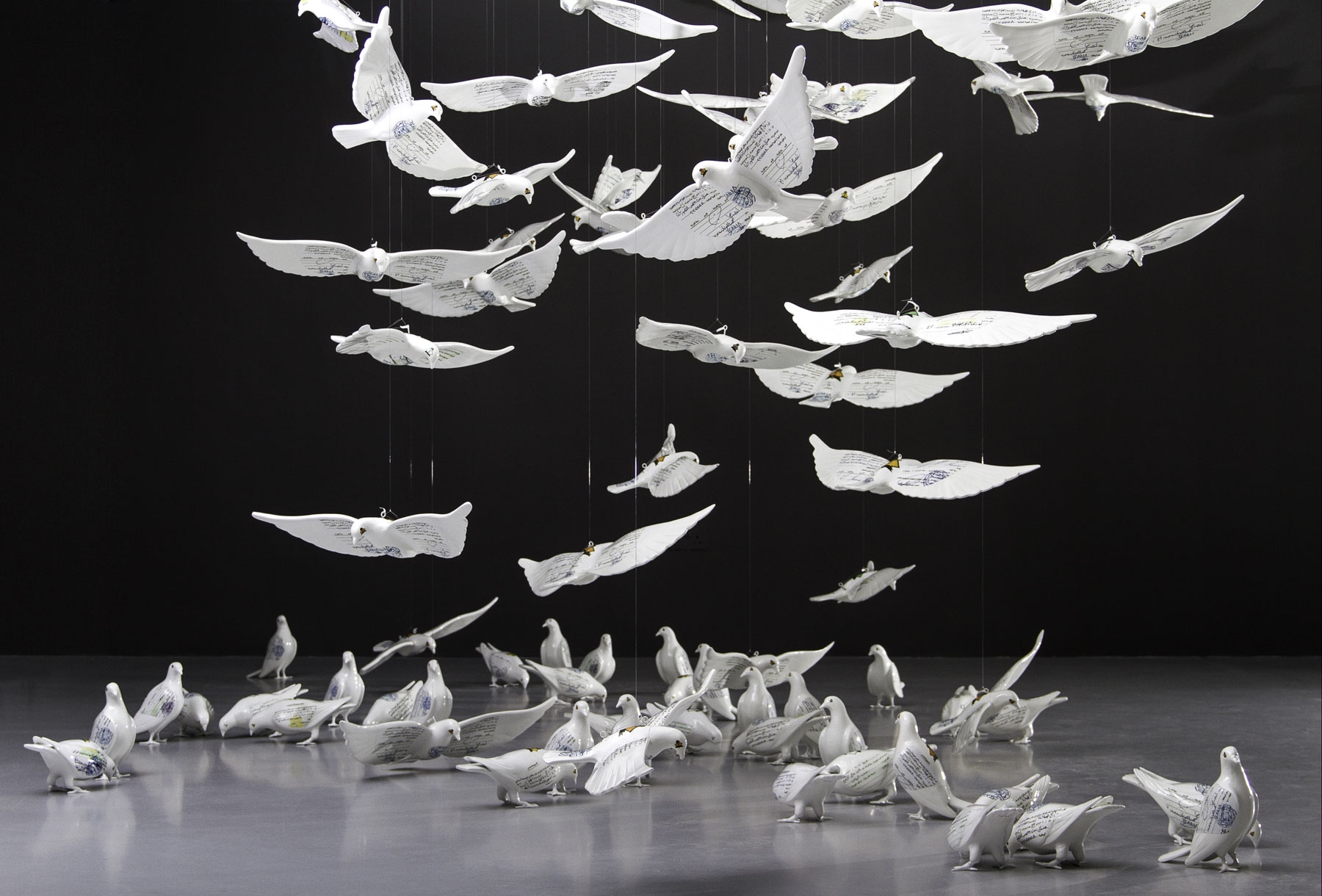
Manal AlDowayan
Manal AlDowayan is a Saudi artist, living and working in Dubai, UAE and Dahran, Saudi Arabia. Born in Dhahran, Saudi Arabia in 1973. Embracing diverse media, Manal AlDowayan’s work encompasses black and white photography, sculpture, video, sound, neon and large-scale participatory installations. Her artistic practice revolves around themes of active forgetting, archives, and collective memory, with a large focus on the state of Saudi women and their representation.
She has documented social groups like the oil men and women of Saudi Arabia in her project, If I Forget You Don’t Forget Me, and has addressed the impact of mass media on propagating intentional erasing of identities in her project Crash, highlighting the unnamed Saudi teachers dying in car crashes across Saudi Arabia. Her participatory projects have attracted hundreds of women to use art as a new platform to address social injustice like Tree of Guardians, Esmi-My Name, and Suspended Together.

Manal AlDowayan
Suspended together (Standing Dove), 2008
Printed porcelain
7 1/10 x 7 9/10 x 12 3/5 in.
18 x 20 x 32 cm.
Editions 10, 14 of 40 + 1AP
Inquire about this workSuspended Together gives the impression of movement and freedom. However, a closer look the dove allows the viewer to realize that its actually frozen and suspended with no hope of flight. An even closer look shows that the dove carries on its body a permission document that allows a Saudi woman to travel. Notwithstanding their circumstances, all Saudi women are required to have this document, issued by their appointed male guardian.
The artist reached out to a large group of leading women from Saudi Arabia to donate their permission documents for inclusion in this artwork. “Suspended Together” carries the documents of award-winning scientists, educators, journalists, engineers, artists and leaders with groundbreaking achievements that gave back to their society.
The installation “Suspended Together” depicts [...] doves [...] carrying permission documents on their white porcelain bodies; these allow Saudi women to travel under the country’s male guardianship system. Eight years since the piece was made, this law has been removed. “My art is historical now!” Manal AlDowayan says, proudly.
Extracted from an interview to Manal AlDowayan by Dalia Dawood in Financial Times. 5 December, 2019.

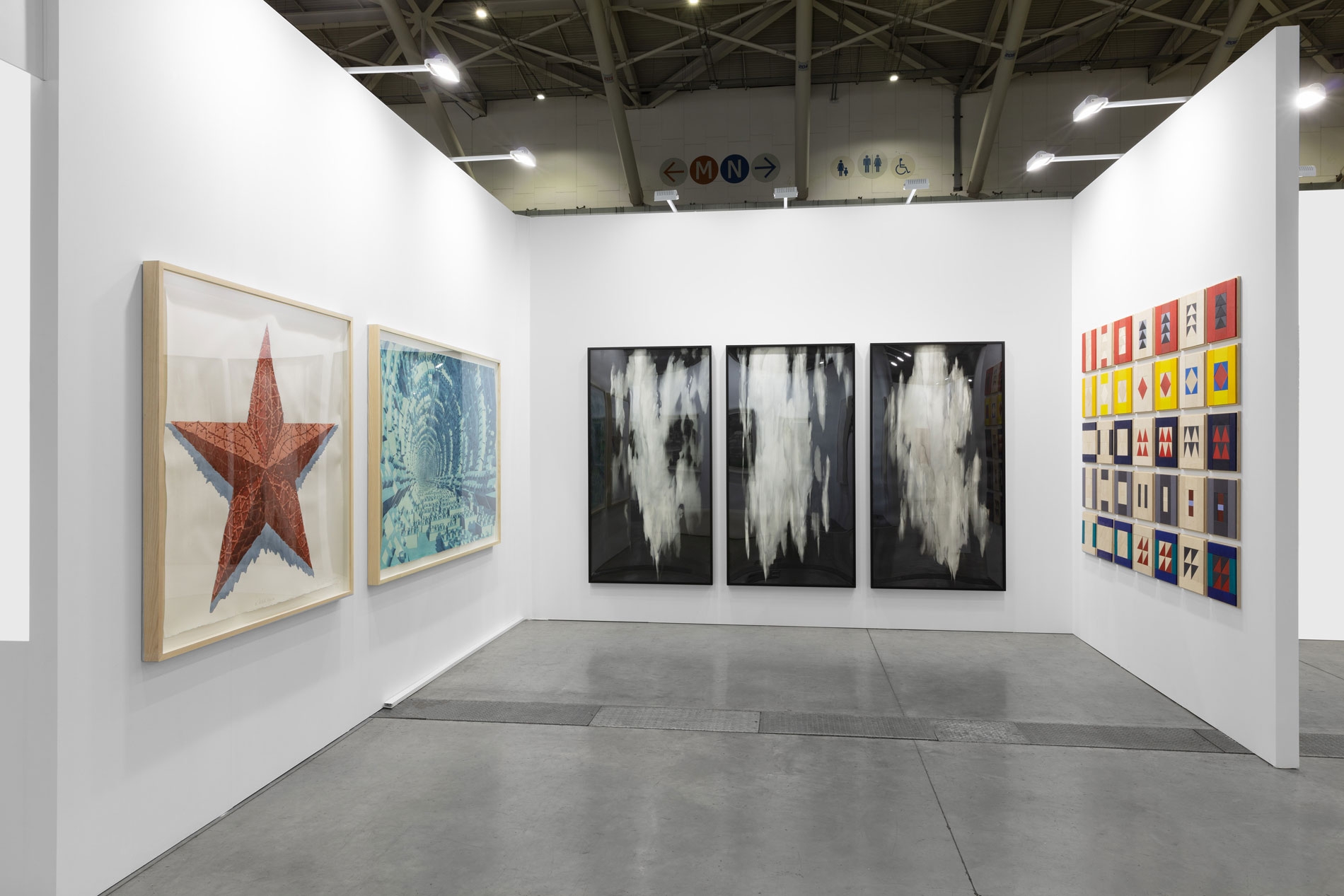
Dagoberto Rodríguez
Dagoberto’s works have been exhibited in museums and cultural institutions around the world and are part of prominent public collections such as MOMA, Whitney Museum of American Art, Guggenheim New York, Centre Georges Pompidou, Tate Modern and Museo Centro de Arte Reina Sofía, among many others.
Combining architecture, design and sculpture, his work employs humor and irony to comment on core topics in art, politics and society. Watercolor forms a very important part of his creative process, it is a way of registering and revising his ideas. Often these works reflect a fantasy of a possible conceptual situation.

Interior de Lego Azul, 2019
Watercolor on paper
51 1/5 x 78 7/10 in.
130 x 200 cm.
Inquire about this workThe tunnel is in itself a polyphony of meanings, a polysemy which symbolizes all the dark, anxious, painful crossings or expectations that can lead to another life. Meticulously executed, the watercolors are of a monumental scale. This medium requires letting go while striking a balance between control and freedom of the gesture. Watercolour is the medium of choice for text illustration, from Egyptian or medieval manuscripts. Immersive, these drawings catch the eye, as if you could pass to the other side of the mirror or get sucked in. They only become even more credible thanks to tenfold illusionist effects that encourage this transition to another world. Dagoberto Rodríguez creates ultra-contemporary and urban narratives of a mechanical, cold and dehumanized world bathed into an electric light … A kind of outside world, closed in itself, enigmatic, without landmarks and of which we do not know if it is dreamlike, dystopic or concrete.
Extracted from the text Trough the Tunnel. Jérôme Sans.
My work is metaphorical and symbolic, however the metaphors often have a profound conceptual value.
Dagoberto Rodríguez, 2019.

No estrella roja dos, 2018
Watercolor on paper
51 1/5 x 51 1/5 in.
130 x 130 cm.
Inquire about this work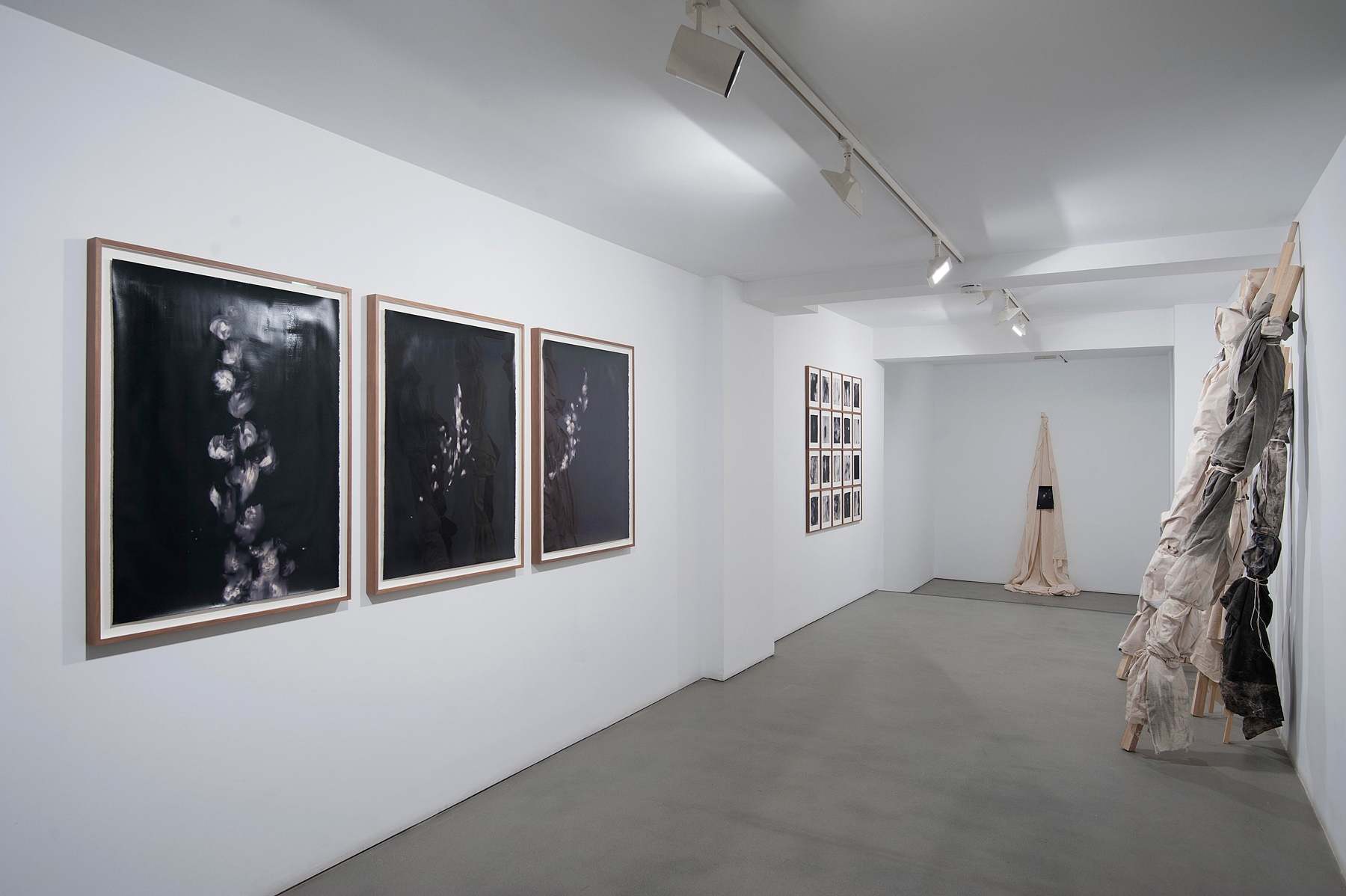
Alexandra Karakashian
Karakashian’s artworks stems from her personal and family history and reflects on current issues of exile, migration and refugee-statues. Process and materiality is key to her practice. Employing used engine oil and salt as a medium for painting, she engages in ecological discussion, the threatening instability and subtle collapse; and the unethical seizing of rapidly dwindling natural resources, particularly on the resource-rich African continent. Furthermore she investigates notions of mourning – both of an individual and collective nature – and the lamentation of the loss of land and of those who have been ‘unhomed’.

Parting I, 2019
Oil on sized paper
78 7/10 x 40 9/10 in
200 x 104 cm.

Parting II, 2019
Oil on sized paper
78 7/10 x 40 9/10 in.
200 x 104 cm.


Joël Andrianomearisoa
Joël Andrianomearisoa’s background as an architect, Malagasy origins and profound interest in arts, define a very particular way of work, mostly playing with spaces and feelings. The emotive intelligence and sensuality of his art works made him the perfect candidate to represent his country at the Venice Biennial, win the Prize Audemars Piget or be part of public colections and museums around the World. Emotions are Andrianomearisoa’s main brush, along with the fabrics, silk papers, or any other raw materials he uses in the process. And so on, the artist creates labyrinths, landscapes, cartographies of desires or spaces also invaded by full poetry such as Inventories of the Present or Tomorrow, Tomorrow…

Joel Andrianomearisoa probes intimacy from a nodal experience: the crystallization of desire. The sensitive world –sensations, sensuality and the memory archives, reminiscences– are the main focus of this course. Space, as it oscillates between the spiritual –epistolary sublimation, images of evanescence– and the carnal –caressing of the tissues– is the space of a sensory memory, and an imaginary world that works it as an object of fantasy.
The space of our life is neither continuous, nor infinite, neither homogeneous, nor isotropic. But do we really know where it shatters, where it curves, and where it assembles itself? We feel a confused sensation of cracks, hiatus, points of friction, sometimes we have the vague impression that it is getting jammed somewhere, or that it is bursting, or colliding.
Georges Perec, Espèces d’espaces

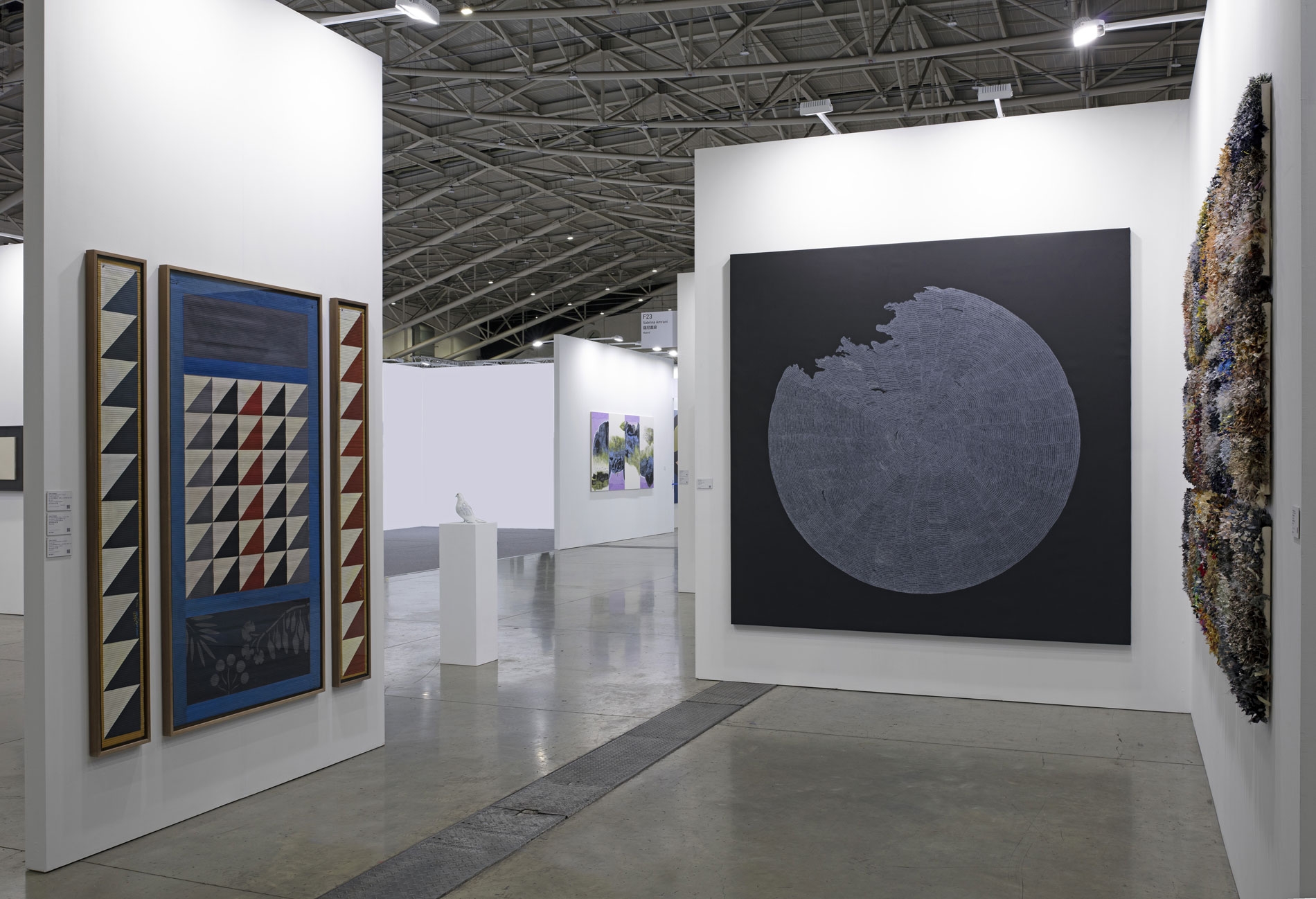
Chant Avedissian
Chant Avedissian was born in Cairo, Egypt, in 1951 and passed away in the same city in 2018. Coming from Christian Armenian traditions due to his origins, but raised and educated inside the Egyptian culture and schools, he and his work had been always committed to the identity of nations, traditions and culture.
Well travelled, Avedissian finds icons from traditional arts and local cultures around the world and transfer them to his own universe, working through a wide range media, including photography ant textiles. Since 1990, his most known work focuses in painted stencils on cardboard, showing the icons he found during his trips all around the world trough several countries, from Egypt to Uzbekistan, Paris to Canada, from Cuba to Greece. Avedissian stencils collect symbols and icons from every corner visited by the artist and translate them into his own artistic language.

Fomation of a Square II, 2017
Wood and acrylic paint
102 2/5 x 70 9/10 in.
260 x 180 cm.
Editions 1-3 of 3
Inquire about this workFormation of a square synthesises the colours, architecture and geometric patterns that are repeated all along the Silk Route. Avedissian observed that nomad traders divided their tents in geometric forms of fabric so the pattern adjusts to a final tent shape. Formation of a square is based on this geometrics and colours through squares containing other geometries of painted wood.
Avedissian’s art is based on – and draws inspiration from – the work of many people, of different places throughout the millennia that the artist discovered on his travels and which always conveyed to him the same elemental forms, colours and designs. Chant Avedissian’s work synthesises the colours, architecture and geometric patterns that are repeated all along the Silk Route and Egypt. This artwork makes up an iconographic archive of Egypt that nourishes his visual discourse about the permeability of cultures. His works can be understood and read as an affirmation of his an own Egyptian identity as well as the uniqueness coming from a collective and universal heritage, that goes beyond all borders: an Eastern identity standing up to Western supremacy.
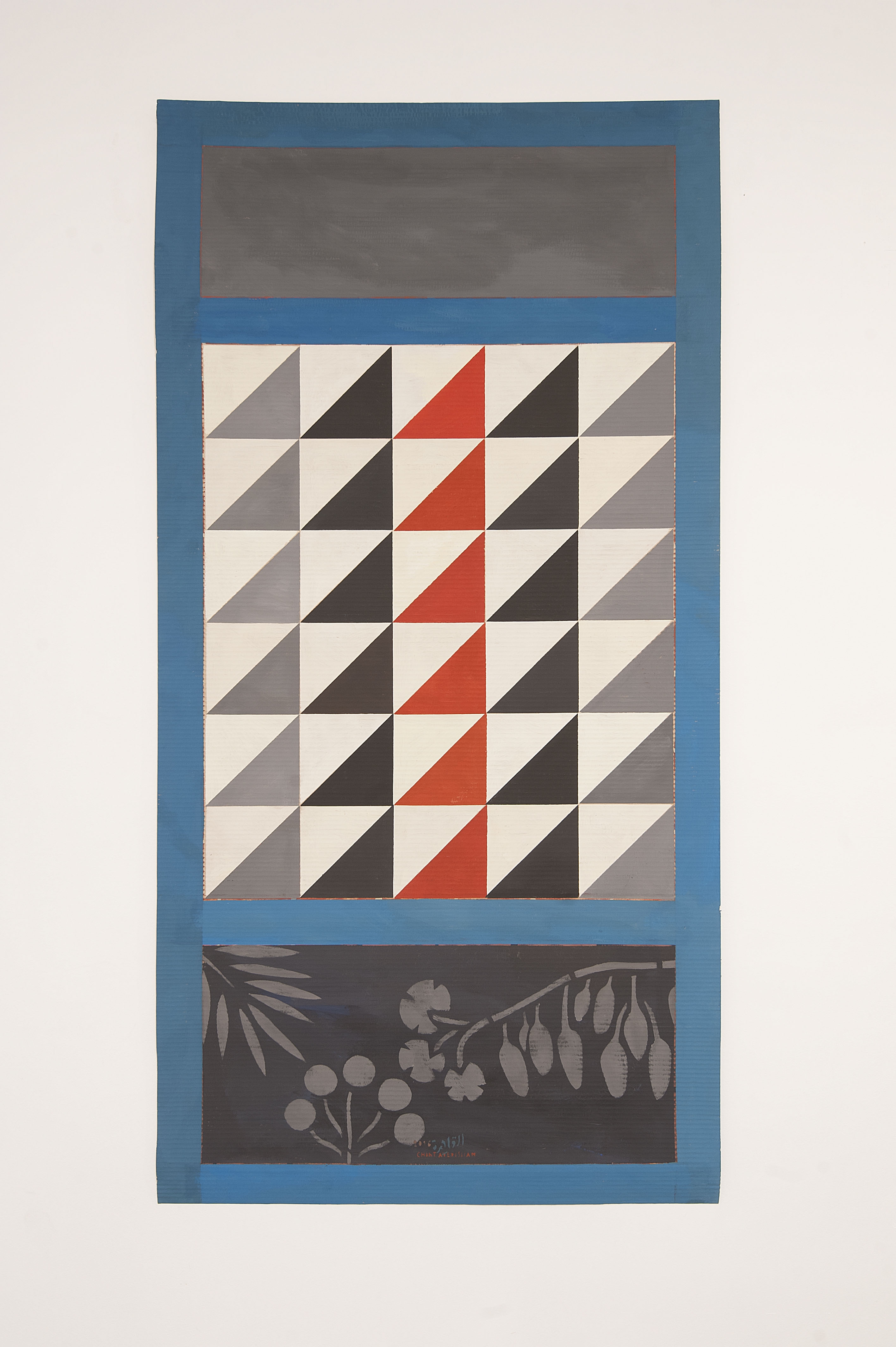
P5 - Ancient Egyptian triangles with plants, 2016
Gouache on corrugated cardboard
70 9/10 x 35 2/5 in
180 x 90 cm
Inquire about this work
B12 - Ancient Egyptian pattern, red triangles on white, 2016
Gouache on corrugated cardboard
70 9/10 x 7 1/10 in.
180 x 18 cm.
Inquire about this workMy art master was the adobe brick.
Putting three bricks together to make a wall, to make a pattern, it’s magic.
Chant Avedissian.

B11 - Ancient Egyptian pattern, dark grey triangles on white, 2016
Gouache on corrugated cardboard
70 9/10 x 7 1/10 in.
180 x 18 cm.
Inquire about this workAvedissian is intrigued by Arab desert life and admires the provisional dwellings of the Bedouins, who can easily pack up and take all their belongings with them. This freedom of movement, of easily moving one’s home and possessions, gave him the idea to make the corrugated cardboard stencils or scrolls, which are easy to produce, change, pack and transport; and can be rearranged in a different order, thus telling alternative stories.
Katerina Gregos. Chant Avedissian, 2017.
Jong Oh
Jong Oh's artistic practice is quite particular since he does not use a studio but creates minimal sculptures in situ that respond to a given spatial situation. Responding to the nuanced configuration of each site, the artist constructs spatial structures by suspending and interconnecting a limited selection of materials: rope, chains, fishing wire, perspex, wooden and metal rods and painted threads. The elements of the work seem to float, and depending on the spatial relationship of the viewer with it these elements are connected and cross each other or appear as absolutely independent, suggesting additional dimensions to the simple three-dimensional space.
Oh appeals to the viewer to question their own perception and the way they have to relate to the space that surrounds them, offering a space for meditation and contemplation before the hustle and bustle of contemporary everyday life: a subtle and refined visual haiku about universality and the sound of space.

Line Sculpture (column) #9, 2020
metal rod, chain, fishing wire
194.5 x 30 x 30 cm.
Inquire about this workJong Oh names ‘Line Sculpture’ to the works that are smaller than our body. In other words, a piece that our body can’t enter.
Although Line Sculptures have a dialogue with the space around it, the dialogue is stronger between the spaces within the sculpture.
The sculptures exists more independently from the space where they are located.
Cuboid series are works that are restricted in a cuboid structure. Dealing with restrictions has always been part of Oh’s art making, and that’s how acceptance became a big part of his philosophy. Restricting himself to work in a certain structure is challenging overtime but it also pushes him to investigate deeply into new forms and materials in a different way from working freely without limits.
In art, as in life, everything depends on the experience, the experience of reality. But what happens when the operation of forces and the relation of forms are materialized in the same experience? That, and the ability of art to question the limits of perception and slow down our relationship with our surroundings, is the subject of the work of Jong Oh.
Octavio Zaya. Towards the Void, 2018.
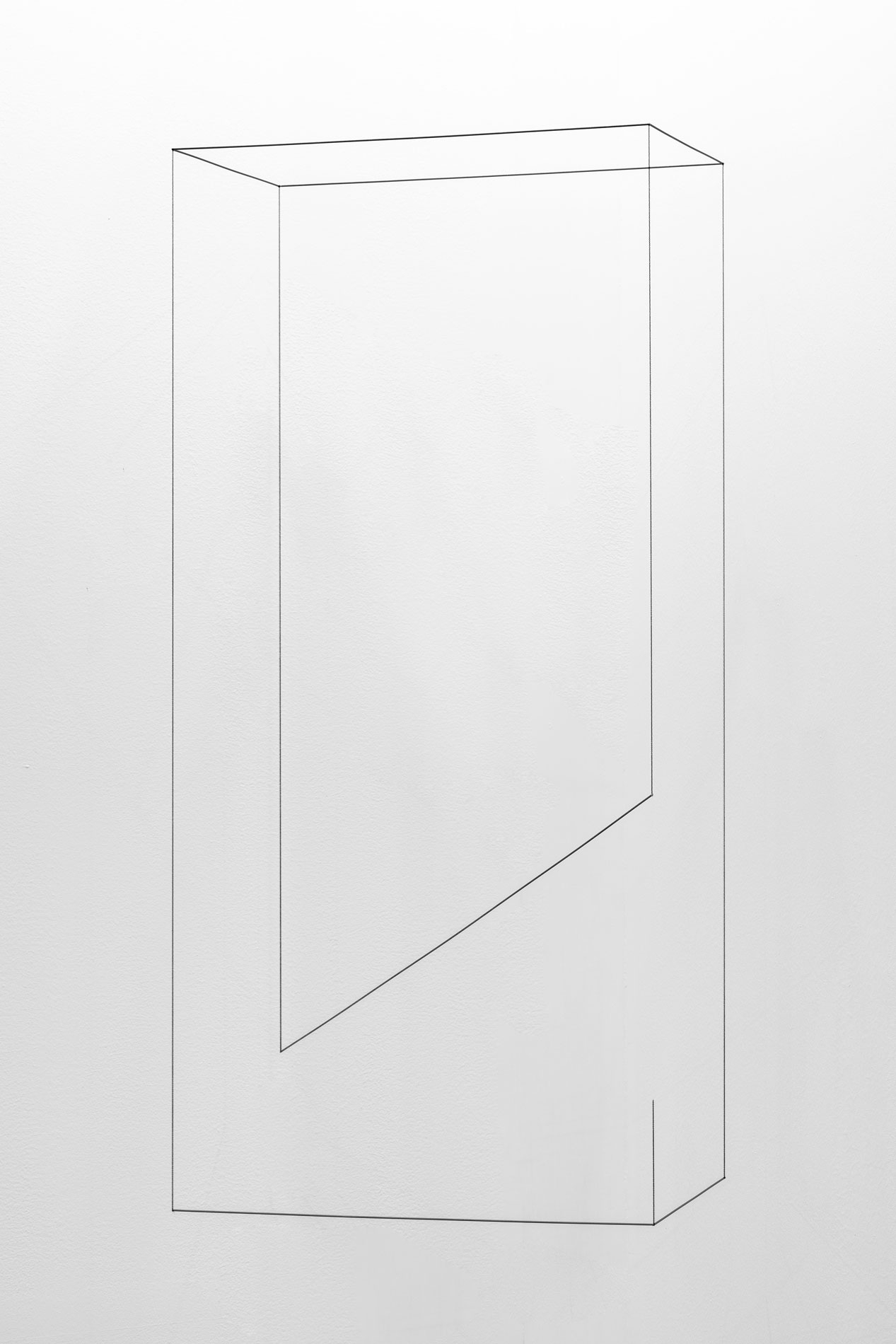
Line Sculpture (cuboid) #37, 2020
metal rod, chain, fishing wire
90 x 42 x 28 cm.
Inquire about this work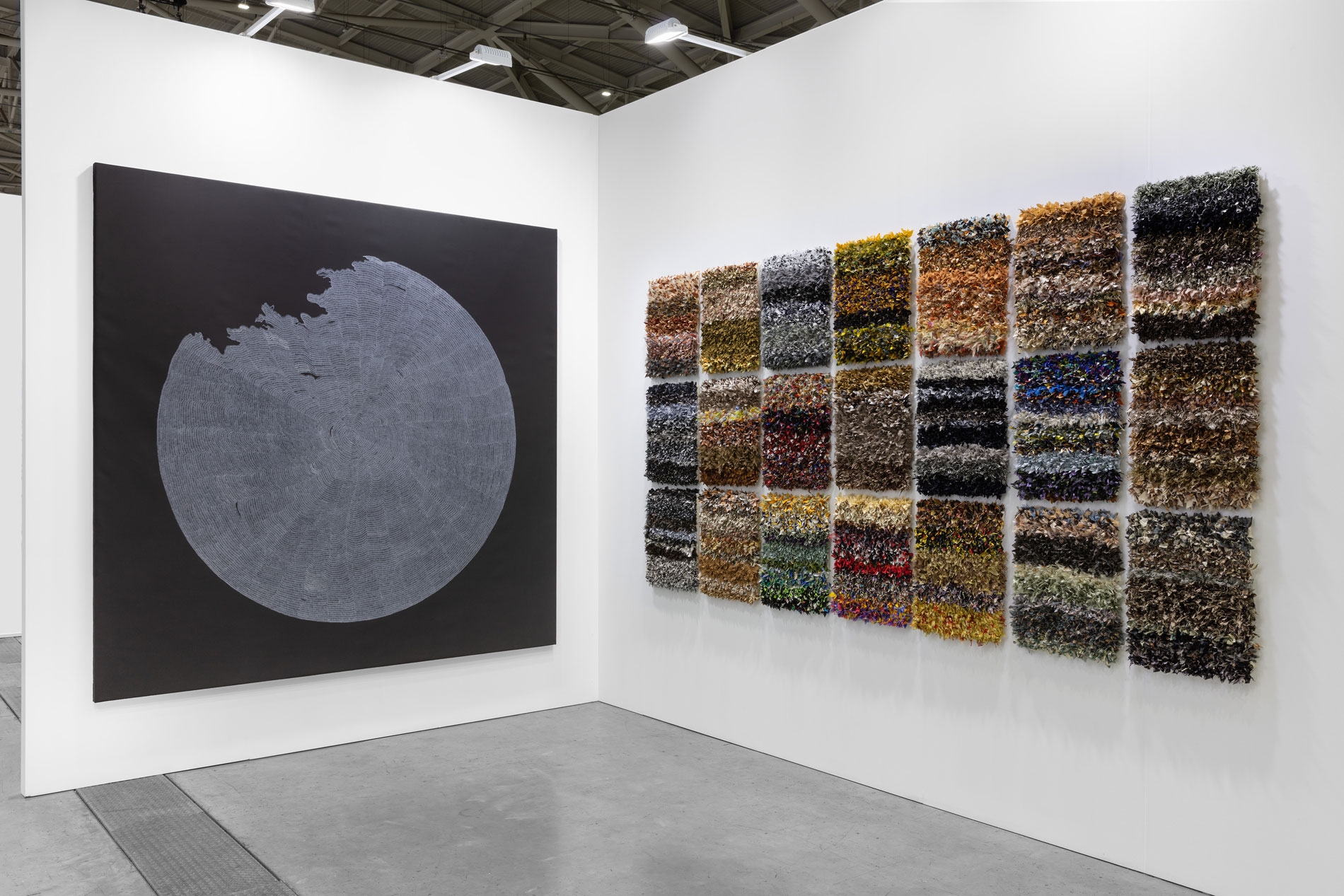
Waqas Khan
Waqas Khan is a Pakistani artist, that lives and works in Lahore, Pakistan. Born in Akhtarabad, Pakistan, in 1982.
Waqas Khan’s large scale minimalist drawings resemble webs and celestial expanses. The contemplation leaving a visible evidence on paper is the crux of the work.
Khan employs small dashes and minuscule dots to create large entanglements. Where when two particle-sque units are spread out and entangled, they are essentially ‘in sync’ with each other, and they’ll stay in sync no matter how far apart they are. This idea of togetherness and being seen one as a magnanimous totality is what he partly absorbs from his inclination towards literature and interest in the lives of sufi poets. Khan’s work also evoke a sense of scripting, which he likes to see as a discourse between him and his viewer, a dialogue which is very much formatted over the syntax of a monologue.
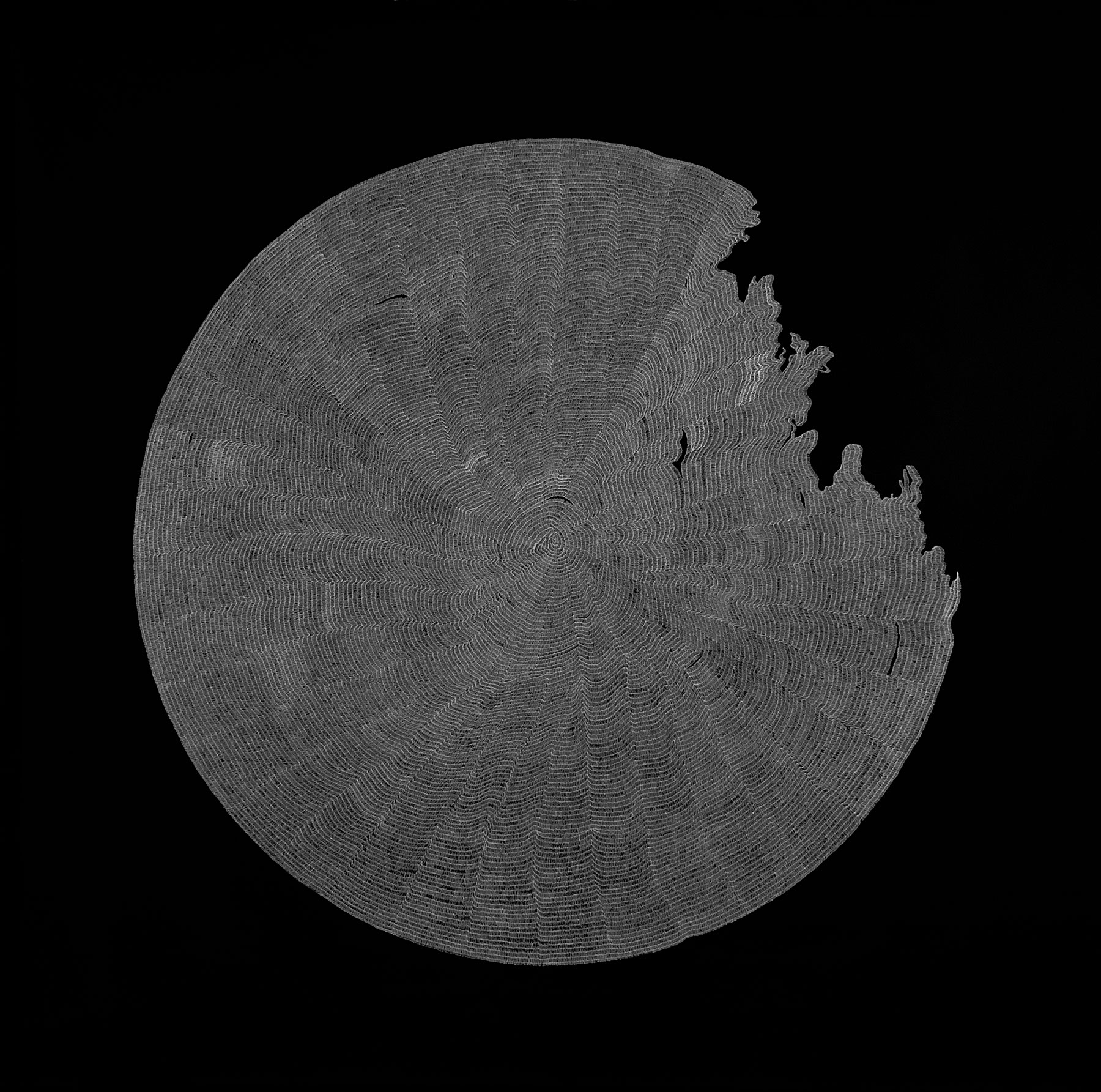
The Gibbous Moon, 2019
Acrylic and ink on canvas
96 1/10 x 96 1/10 in.
244 x 244 cm.
A very special piece. In strict concordance with Waqas Khan’s working process and timings: each artwork needs hours, days, weeks, some even months of concentration, breathing in and breathing out, to see the light. The piece ‘The Gibbous Moon’ follows the technics Waqas has developed but changes the surface, his long time loved Wasli paper, and uses a large canvas instead. Even further, the canvas is previously covered in black acrylic, so the artists’ white ink stroke changes radically. The ink on the paint reacts directly to the strokes creating a very different depth and quality, touching the artwork with a completely different dimension and spatial projection.

The Gibbous Moon, 2019
Acrylic and ink on canvas
96 1/10 x 96 1/10 in.
244 x 244 cm.
Inquire about this workKhan’s meditative works are created by the contact between his hand and the wasli paper; Khan’s emotions drive his hand, and a simple change in his breathing or the tension with which he holds the pen will completely transform the stroke of his instrument.
Diana Campbell Betancourt. The Untitled Show, 2014.
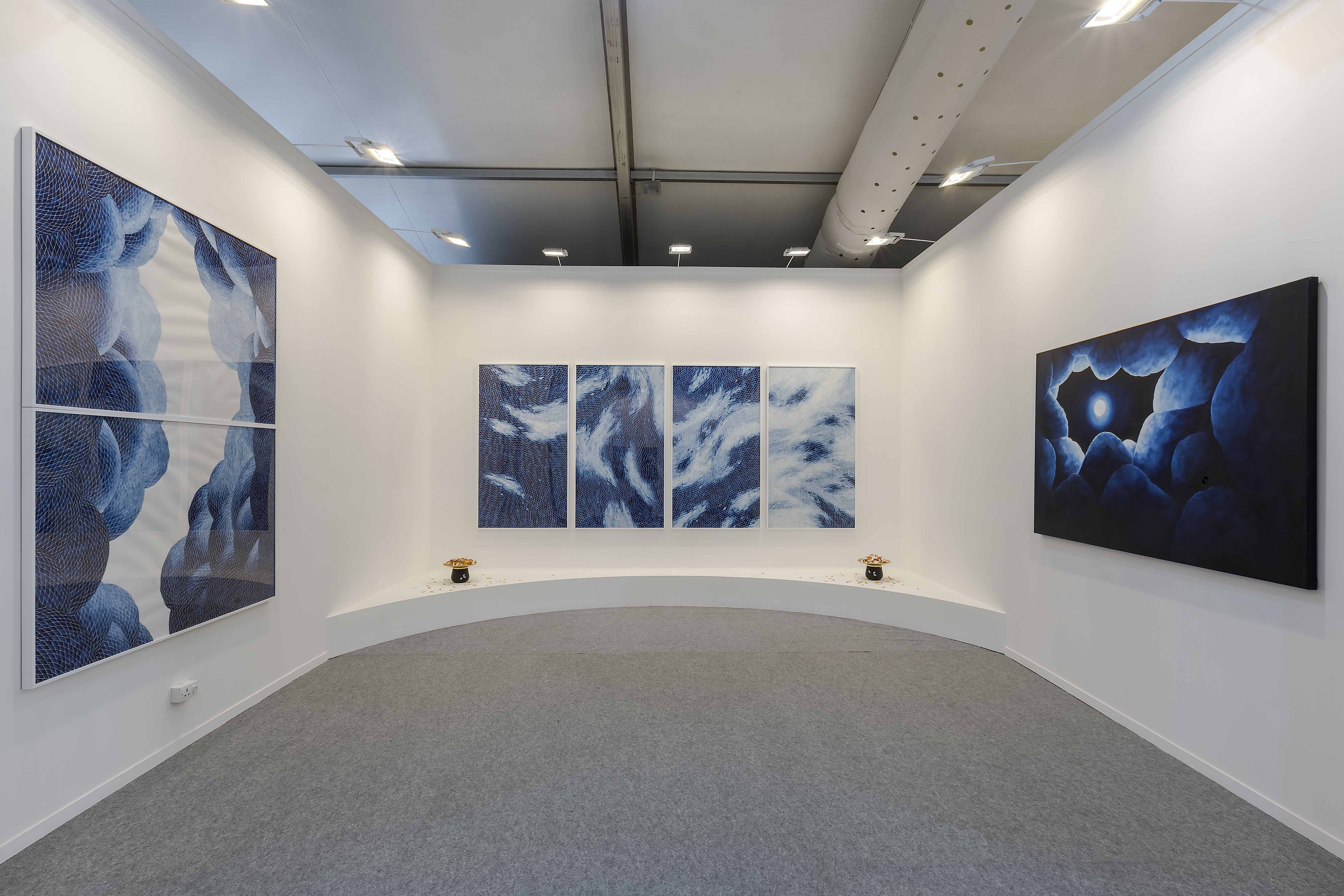
Timothy Hyunsoo Lee
Hyunsoo Lee’s works are inspired by themes of social stigma, identity, psychological disorders, and more recently, of spirituality and religion. He explores these themes through a novel vector – paintings and sculptures consisting largely of cell-like marks that vary in size, color, and saturation. His works are seen as ethereal and delicate, but the extremely labor-intensive compositions, marked by intensely obsessive repetitions, quickly betray that initial perception. Exploring his own history of anxiety disorders through his art, Timothy confronts and manipulates his tics and compulsions and channels them into his works. In responding to his anxiety with art, he has developed a novel system of mind-mapping – “a cartography of his psychopathology” – to study a part of himself that initially drew him to study developmental biology and neuroscience in college.
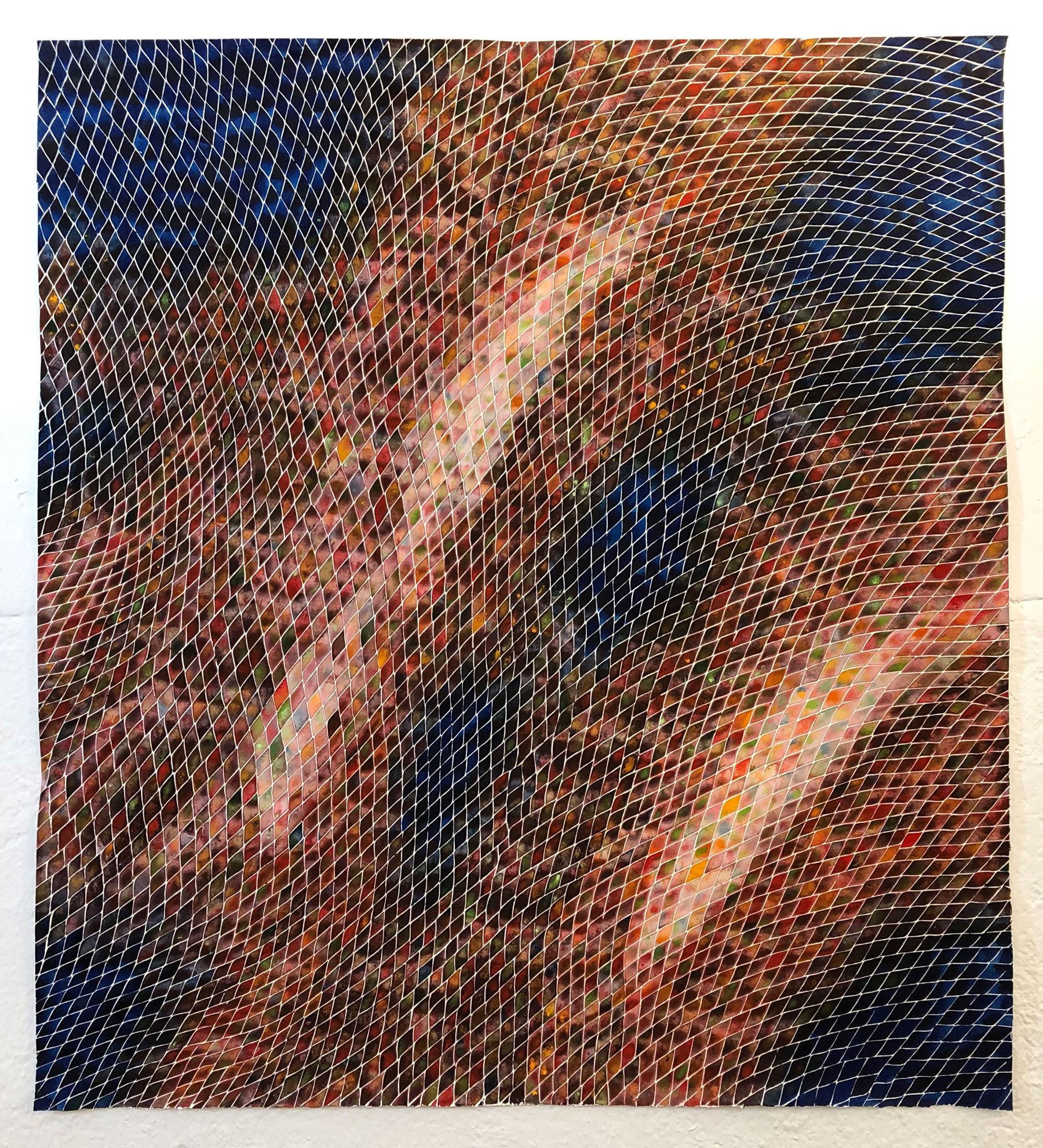
The Traces series began in 2014, and was the first body of work Timothy Hyunsoo Lee created when he left the laboratory to be an artist in the studio. He called these works Traces because it's a double entendre that suggests his interest in investigating a part of his identity that is both ongoing and residual. The rendering of each "cell" underlies a formal investigation of his anxiety, both as a Korean and as an individual with chronic anxiety and nightmares. Timothy’s anxious self allows him to sit down for hours, even nights, meticulously painting thousands of dots without any foresight as to how the composition will turn out - his works are dictated by visceral reactions that he gets channeling his compulsions and tics into a visual language. Thus, he traces psychopathologies through a novel method of "mind mapping" in hopes of better understanding how he thinks and views the world.